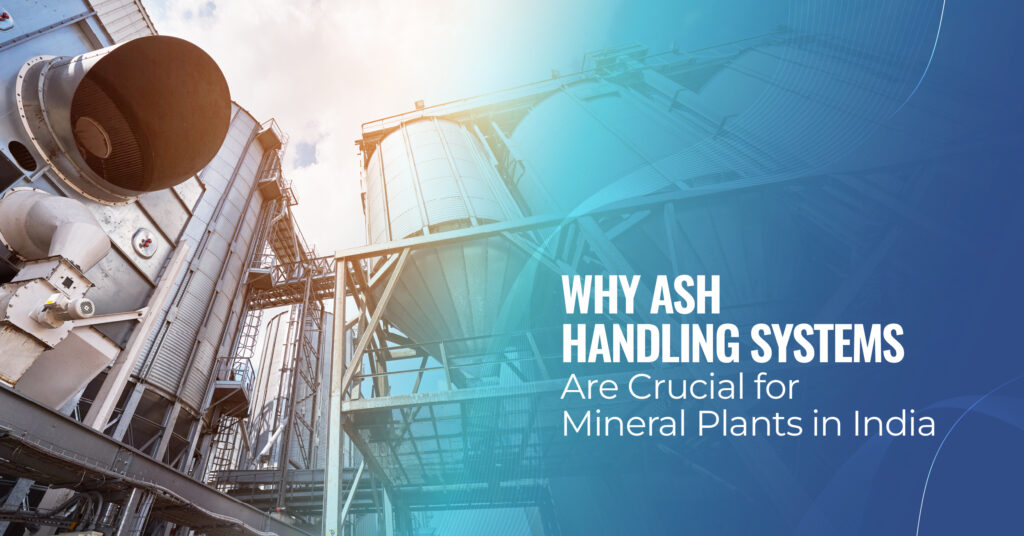Why Ash Handling Systems Are Crucial for Mineral Plants in India

Pneumatic Conveying System
A reliable ash handling system is the unseen backbone of India’s mineral plants. Every tonne of coal or mineral processing generates ash as a byproduct, and without the right system in place, this waste can quickly turn into an environmental and operational hazard. In mineral-rich states across India, from Odisha to Chhattisgarh, handling ash safely and efficiently is essential not just for productivity but also for meeting strict environmental standards. This guide explores what ash handling systems do, how they work, their advantages, and why they are indispensable for India’s mineral industries.
This guide explores what ash handling systems do, how they work, their advantages, and why they are indispensable for India’s mineral industries.
What Is An Ash Handling System?
An ash handling system is designed to collect, convey, and dispose of ash generated during mineral processing, power generation, or industrial combustion. Unlike manual removal, which is hazardous and inefficient, an AHS automates the transport of ash from the source to silos, hoppers, or disposal points.
Types of systems include:
- Pneumatic conveying systems – using air pressure or vacuum to transport ash over long distances.
- Hydraulic systems – using water as the conveying medium.
- Mechanical systems – using conveyors, scrapers, or chain links.
Modern systems are typically enclosed, preventing dust escape and ensuring worker safety.
Why Do Mineral Plants In India Need Ash Handling Systems?
India’s mineral plants face unique pressures: large volumes of ash, regulatory scrutiny, and proximity to populated areas. Without a proper system, plants risk:
- Violating environmental compliance norms.
- Facing high operational costs due to manual handling.
- Exposing workers to hot, toxic ash.
- Losing efficiency from unplanned shutdowns caused by ash build-up.
A structured ash handling setup reduces these risks while boosting reliability and sustainability.
How Does An Ash Handling System Work?
Most ash handling systems follow a staged process:
- Collection – Ash is gathered at hoppers of boilers, furnaces, or processing units.
- Cooling/conditioning – High-temperature ash is cooled to protect downstream equipment.
- Conveying – Pneumatic or mechanical systems transport the ash to silos, hoppers, or vessels.
- Storage/Disposal – Ash is stored safely or directed towards environmentally conscious disposal methods.
Automation ensures smooth operation with minimal human involvement, lowering both risks and costs.
Key Benefits Of An Ash Handling System
1. Environmental Safety
- Prevents air and water pollution from ash mishandling.
- Uses enclosed transport systems to avoid spillage.
- Helps mineral plants stay compliant with Indian environmental regulations.
2. Cost-Effective & Low Maintenance
- Cuts down labour costs by eliminating manual ash handling.
- Modern systems use durable components designed for long life.
- Low velocity conveying minimises wear and tear, ensuring reliability.
3. Enhanced Worker Safety
- Reduces direct exposure to hot, toxic ash.
- Lowers health risks from hazardous chemicals and byproducts.
- Automation removes the need for workers to intervene in dangerous zones.
Common Challenges In Ash Management And How To Address Them
| Common Challenges | Solutions |
|---|---|
| High wear and tear | Use abrasion-resistant materials and low-velocity conveying |
| Frequent downtime | Introduce redundant systems and scheduled maintenance |
| Dust leakage | Upgrade to enclosed conveyors and pneumatic systems |
| Regulatory pressure | Adopt systems with proven compliance to CPCB norms |
Role Of Automation In Modern Ash Handling Systems
Automation has become a cornerstone of modern ash handling operations, reshaping efficiency, control, and compliance. Rather than functioning as isolated mechanical systems, today’s ash handling lines are integrated with intelligent process automation tools that monitor, regulate, and optimize every stage of operation.
Key automation features include:
- Sensors and PLC-based controls: Continuously track pressure, temperature, and flow to optimise conveying speeds and detect blockages or equipment wear before failures occur.
- Supervisory Control and Data Acquisition (SCADA): Provides real-time visibility across collection, conveying, and storage points, allowing remote supervision and performance adjustments.
- Automated silo and valve management: Ensures timely ash disposal and even load distribution, avoiding manual errors and system overloads.
- Data-driven decision making: Captures operational metrics for predictive maintenance, energy optimisation, and compliance reporting.
How Do Ash Handling Systems Support Sustainability And Compliance?
Sustainability and compliance have become central to how mineral plants in India operate. A modern ash handling system directly contributes to both by reducing environmental impact, conserving resources, and ensuring alignment with stringent regulations such as those set by the CPCB and MoEFCC.
Environmental and Operational Benefits:
- Reduced emissions: Enclosed systems and dust-tight conveyors prevent particulate matter from entering the atmosphere, supporting cleaner air around industrial areas.
- Lower water usage: Dry and pneumatic systems significantly cut down water dependency compared to hydraulic setups, helping conserve local water resources.
- Efficient energy use: Optimised conveying speeds, shorter transfer routes, and automated operation reduce power consumption across the plant.
- Regulatory compliance: Properly engineered systems help plants stay within statutory emission and waste disposal limits, avoiding penalties and ensuring sustainable production.
- Waste reuse and by-product valorisation: Collected ash can be repurposed in cement, brick manufacturing, or land reclamation, turning waste into value.
- Long-term sustainability: Continuous monitoring and automated controls reduce maintenance frequency, ensuring long operational life and minimal environmental footprint.
Together, these features ensure that an ash handling system is not just a compliance requirement but a vital part of a plant’s sustainability and efficiency roadmap.
Conclusion
For India’s mineral plants, investing in a robust ash handling system is no longer optional; it is critical for operational safety, environmental compliance, and long-term cost efficiency. By automating the transport and disposal of ash, these systems safeguard workers, reduce downtime, and ensure that plants can meet both production and sustainability goals.
At Rieco, our ash handling systems are designed with flexibility in mind. We customise solutions for diverse industries, ensuring safe, reliable ash transfer over long distances, whether to silos, transport vessels, or eco-friendly disposal routes.




